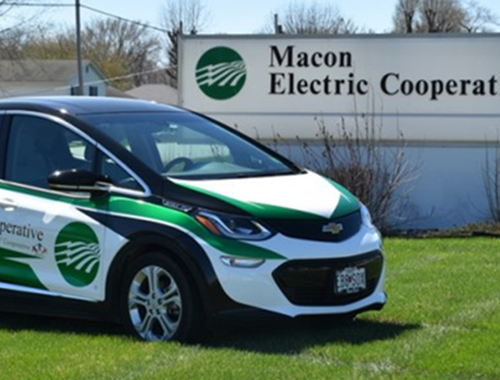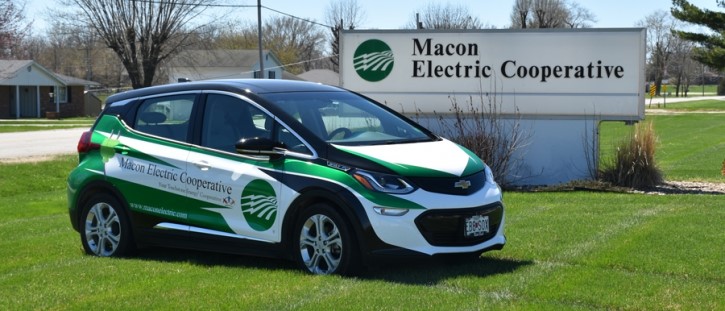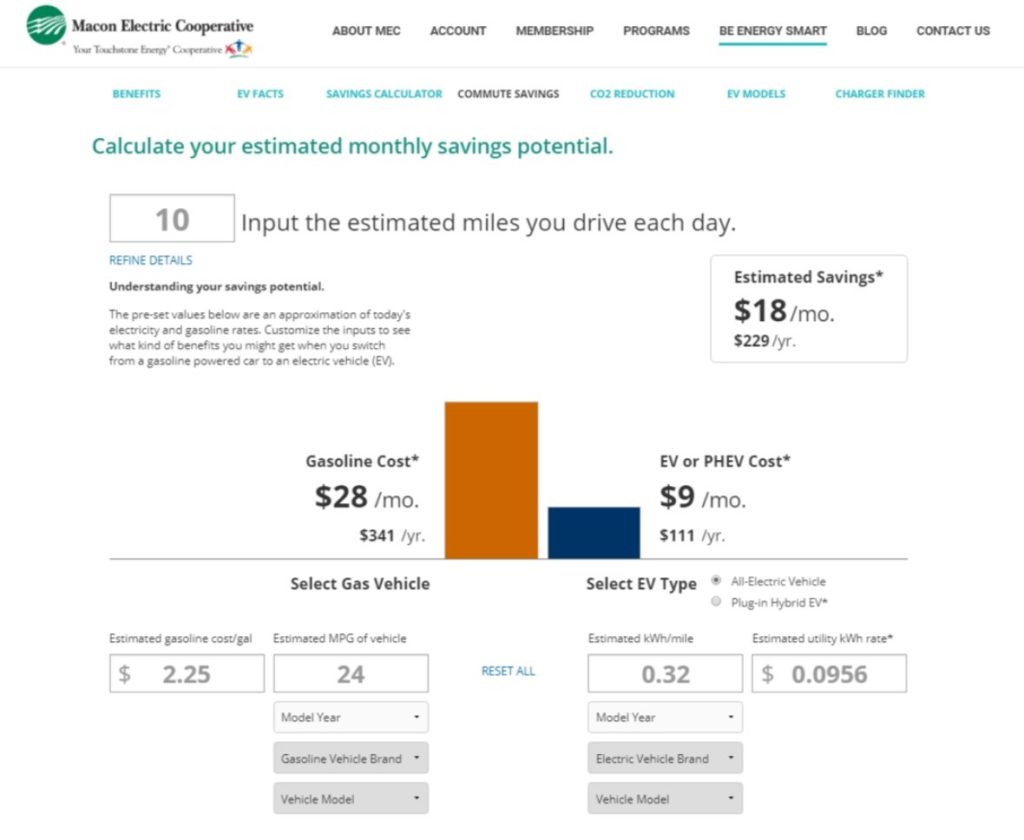
10 Oct Spotlight on Macon Electric Co-op

Macon Electric Co-op shows off their custom-wrapped 2017 Chevy Bolt.
BY BRIAN BOOHER, D+R INTERNATIONAL
Rural electric cooperatives are sometimes overlooked in the conversation about transforming how the U.S. generates and consumes energy. As it turns out, many of these community-focused organizations are leading the way. One of the best examples is Macon Electric Cooperative (MEC) in Missouri. This year, MEC has launched a new website to educate its 8,000 members about the benefits of electric vehicles and is looking into providing incentive for EVs and ENERGY STAR certified EV chargers.
According to Allie Bennett, Marketing and Communications Manager for MEC, promoting EVs is a perfect fit for co-ops. “Co-ops were founded to improve the quality of life of rural communities. We can help our members learn about and get access to new technologies. Rural areas tend to always get the new technologies last, but if the co-op is at the forefront, we can help it get there more quickly.” In addition, EVs are both environmentally friendly and can save members money. “People view EVs as more expensive, but we want to show how people can save so much money,” says Bennett, “That’s the number one reason we want to promote EVs.”
But there is also a very important business case for co-ops to promote EVs. The success of energy efficient lighting and equipment and the rapid growth of distributed renewable sources is cutting load demand. Without load growth, the co-op may not be able to sustain itself, which would hurt members. A typical EV will need to recharge about 10-15 kWh per day. That means that just two EVs can equal an entire house’s daily electricity demand. From a dollar standpoint, if 20 EVs were sold in MEC territory, it would bring in an additional $12,000 in revenue per year.
So how is MEC planning to promote EVs? The very first thing they did was to buy one for themselves. With a custom MEC brand wrapping, the 2017 Chevy Bolt makes a strong statement driving around the service territory, at county fairs, and in local parades. At events, it’s a great way to bring in members and start a conversation. Bennett explains, “Members love to look under the hood and learn about the technology. They ask great questions, and we developed a Q&A sheet to make sure to make sure we have the answers. Ultimately, the conversation comes down to ‘how would this work for me?’”

Macon Electric Co-op’s electric vehicle web page lets consumers calculate how much an EV can save based on their driving patterns.
MEC’s new EV website, powered by ChooseEV, gives members the answers they need. Members can visit the website learn about how different types of EVs and EV chargers work, what models are available, and where to find the nearest EV chargers. Members can also calculate cost savings by inputting details about their own driving patterns, all from the comfort of home. Now, Bennett wants to get the word out that this resource is available with the understanding that educating members about electric vehicles will increase adoption in the service territory.
The investment in education and marketing is only the beginning of MEC’s electric transportation strategy. Bennett has been working with MEC’s Board of Directors to develop possible incentives for electric vehicles and ENERGY STAR certified Level II chargers. Owning EVs will save members money over time, but the upfront cost is currently higher than ICE (internal combustion engine) vehicles. Utility incentives can jumpstart demand and make EVs accessible to people that might not have a lot of extra disposable income.
Ultimately, the co-op only benefits from greater EV adoption if those EVs can charge on MEC meters. Like many rural areas, widespread charging infrastructure is lacking in MEC territory and in neighboring territories. Bennett recently took a road trip from Macon to Columbia, about 60 miles away, and couldn’t find a charger at her destination. Luckily she wasn’t stranded, but it underscored the need to build out charging infrastructure. Most EV owners will find that charging at home overnight or while parked at work meets their daily needs; however, having a visible public infrastructure will relieve “range anxiety” for rural commuters. MEC is exploring options for a public charging station, including a truck stop near two major highways, a local Comfort Inn, or in front of the MEC office.
Bennett hopes that MEC’s efforts will influence other Missouri co-ops to adopt similar educational tools and transportation electrification strategies. MEC’s territory covers 9 counties and it is part of a larger tiered system of generation, transmission, and distribution co-ops that cover the state of Missouri. These shared relationships (and in the case of MEC and neighboring Lewis County Electric Co-op, shared general managers) makes it possible to coordinate on strategies and share best practices.
According to NRECA, electric co-ops across the country power over 20 million commercial, residential and institutional buildings, cover 56% of U.S. land area, and sell 13% of all electricity consumed. The electric co-op model emerged during the Great Depression to build the infrastructure that the big utilities wouldn’t and help small towns and rural areas prosper economically, and they continue that mission today. In this way, embracing the electric vehicle revolution is a natural fit for rural electric co-ops, as long as the investment pays off for the members.
“MEC is very forward thinking,” says Bennett, “I think some people are watching to see how it works for us.” With a solid educational platform and clear roadmap, MEC is well poised to succeed and be a model for others.
D+R Insight
Sign up to receive the latest news from D+R International.

